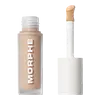What's inside
What's inside
 Key Ingredients
Key Ingredients

 Benefits
Benefits

 Concerns
Concerns

 Ingredients Side-by-side
Ingredients Side-by-side

Water
Skin ConditioningDimethicone
EmollientTalc
AbrasivePhenyl Trimethicone
Skin ConditioningCetyl PEG/PPG-10/1 Dimethicone
EmulsifyingIsododecane
EmollientGlycerin
HumectantHdi/Trimethylol Hexyllactone Crosspolymer
Phenoxyethanol
PreservativeAcrylates/Dimethicone Copolymer
Skin ConditioningSodium Chloride
MaskingHydrogen Dimethicone
Magnesium Sulfate
Dimethicone/Vinyl Dimethicone Crosspolymer
Skin ConditioningSodium Dehydroacetate
PreservativeAluminum Hydroxide
EmollientDisteardimonium Hectorite
StabilisingBenzoic Acid
MaskingTetrasodium EDTA
Dehydroacetic Acid
PreservativePropylene Carbonate
SolventEthylhexylglycerin
Skin ConditioningSilica
AbrasiveButyrospermum Parkii Butter
Skin ConditioningLavandula Angustifolia Oil
MaskingCI 77891
Cosmetic ColorantIron Oxides
Water, Dimethicone, Talc, Phenyl Trimethicone, Cetyl PEG/PPG-10/1 Dimethicone, Isododecane, Glycerin, Hdi/Trimethylol Hexyllactone Crosspolymer, Phenoxyethanol, Acrylates/Dimethicone Copolymer, Sodium Chloride, Hydrogen Dimethicone, Magnesium Sulfate, Dimethicone/Vinyl Dimethicone Crosspolymer, Sodium Dehydroacetate, Aluminum Hydroxide, Disteardimonium Hectorite, Benzoic Acid, Tetrasodium EDTA, Dehydroacetic Acid, Propylene Carbonate, Ethylhexylglycerin, Silica, Butyrospermum Parkii Butter, Lavandula Angustifolia Oil, CI 77891, Iron Oxides
Water
Skin ConditioningOctyldodecanol
EmollientPropanediol
SolventGlycerin
HumectantDiphenylsiloxy Phenyl Trimethicone
Skin ConditioningCoco-Caprylate/Caprate
EmollientSimmondsia Chinensis Seed Oil
EmollientPolyglyceryl-3 Polyricinoleate
EmulsifyingIsododecane
EmollientAcrylates/Dimethicone Copolymer
Skin ConditioningGlyceryl Caprylate
EmollientSorbitan Isostearate
EmulsifyingDisodium Stearoyl Glutamate
CleansingSodium Chloride
MaskingDisteardimonium Hectorite
StabilisingAluminum Hydroxide
EmollientPolyhydroxystearic Acid
EmulsifyingSodium Hyaluronate
HumectantAlgae Extract
EmollientArnica Montana Flower Extract
MaskingTocopherol
AntioxidantLeuconostoc/Radish Root Ferment Filtrate
AntimicrobialTremella Fuciformis Extract
HumectantPentylene Glycol
Skin Conditioning1,2-Hexanediol
Skin ConditioningFructose
HumectantUrea
BufferingCitric Acid
BufferingSodium Hydroxide
BufferingEthyl Hexanediol
SolventIpomoea Batatas Root Extract
Skin ConditioningHydroxyacetophenone
AntioxidantMaltose
MaskingSodium PCA
HumectantSodium Lactate
BufferingTrehalose
HumectantAllantoin
Skin ConditioningGlucose
HumectantTitanium Dioxide
Cosmetic ColorantCI 77491
Cosmetic ColorantCI 77492
Cosmetic ColorantCI 77499
Cosmetic ColorantWater, Octyldodecanol, Propanediol, Glycerin, Diphenylsiloxy Phenyl Trimethicone, Coco-Caprylate/Caprate, Simmondsia Chinensis Seed Oil, Polyglyceryl-3 Polyricinoleate, Isododecane, Acrylates/Dimethicone Copolymer, Glyceryl Caprylate, Sorbitan Isostearate, Disodium Stearoyl Glutamate, Sodium Chloride, Disteardimonium Hectorite, Aluminum Hydroxide, Polyhydroxystearic Acid, Sodium Hyaluronate, Algae Extract, Arnica Montana Flower Extract, Tocopherol, Leuconostoc/Radish Root Ferment Filtrate, Tremella Fuciformis Extract, Pentylene Glycol, 1,2-Hexanediol, Fructose, Urea, Citric Acid, Sodium Hydroxide, Ethyl Hexanediol, Ipomoea Batatas Root Extract, Hydroxyacetophenone, Maltose, Sodium PCA, Sodium Lactate, Trehalose, Allantoin, Glucose, Titanium Dioxide, CI 77491, CI 77492, CI 77499
Ingredients Explained
These ingredients are found in both products.
Ingredients higher up in an ingredient list are typically present in a larger amount.
This polymer has film-forming properties and helps leave behind a soft film on the skin with oxygen permeability.
That's why you'll most likely find this in sunscreen formulations.
Aluminum Hydroxide is a form of aluminum. It can be naturally found in nature as the mineral gibbsite. In cosmetics, Aluminum Hydroxide is used as a colorant, pH adjuster, and absorbent.
As a colorant, Aluminum Hydroxide may add opacity, or reduce the transparency. Aluminum hydroxide is contains both basic and acidic properties.
According to manufacturers, this ingredient is an emollient and humectant. This means it helps hydrate the skin.
In medicine, this ingredient is used to help relieve heartburn and help heal ulcers.
There is currently no credible scientific evidence linking aluminum hydroxide in cosmetics to increased cancer risk.
Major health organizations allow the use of aluminum hydroxide in personal care products and have not flagged it as a carcinogenic risk at typical usage levels.
Learn more about Aluminum HydroxideDisteardimonium Hectorite comes from the clay mineral named hectorite. It is used to add thickness to a product.
It can also help stabilize a product by helping to disperse other ingredients.
Hectorite is a rare, white clay mineral.
Learn more about Disteardimonium HectoriteGlycerin is already naturally found in your skin. It helps moisturize and protect your skin.
A study from 2016 found glycerin to be more effective as a humectant than AHAs and hyaluronic acid.
As a humectant, it helps the skin stay hydrated by pulling moisture to your skin. The low molecular weight of glycerin allows it to pull moisture into the deeper layers of your skin.
Hydrated skin improves your skin barrier; Your skin barrier helps protect against irritants and bacteria.
Glycerin has also been found to have antimicrobial and antiviral properties. Due to these properties, glycerin is often used in wound and burn treatments.
In cosmetics, glycerin is usually derived from plants such as soybean or palm. However, it can also be sourced from animals, such as tallow or animal fat.
This ingredient is organic, colorless, odorless, and non-toxic.
Glycerin is the name for this ingredient in American English. British English uses Glycerol/Glycerine.
Learn more about GlycerinIsododecane is a fragrance, emollient, and solvent.
As an emollient, it helps your skin stay soft and hydrated. Emollients help trap moisture into your skin.
Isododecane's role as a solvent makes it a great texture enhancer. It spreads smoothly on skin and does not leave a sticky feeling behind. Isododecane also helps prevent color transfer in makeup products.
Isododecane is not absorbed into skin.
Learn more about IsododecaneChances are, you eat sodium chloride every day. Sodium Chloride is also known as table salt.
This ingredient has many purposes in skincare: thickener, emulsifier, and exfoliator.
You'll most likely find this ingredient in cleansers where it is used to create a gel-like texture. As an emulsifier, it also prevents ingredients from separating.
There is much debate on whether this ingredient is comedogenic. The short answer - comedogenic ratings don't tell the whole story. Learn more about comegodenic ratings here.
The concensus about this ingredient causing acne seems to be divided. Research is needed to understand if this ingredient does cause acne.
Scrubs may use salt as the primary exfoliating ingredient.
Learn more about Sodium ChlorideWater. It's the most common cosmetic ingredient of all. You'll usually see it at the top of ingredient lists, meaning that it makes up the largest part of the product.
So why is it so popular? Water most often acts as a solvent - this means that it helps dissolve other ingredients into the formulation.
You'll also recognize water as that liquid we all need to stay alive. If you see this, drink a glass of water. Stay hydrated!
Learn more about Water